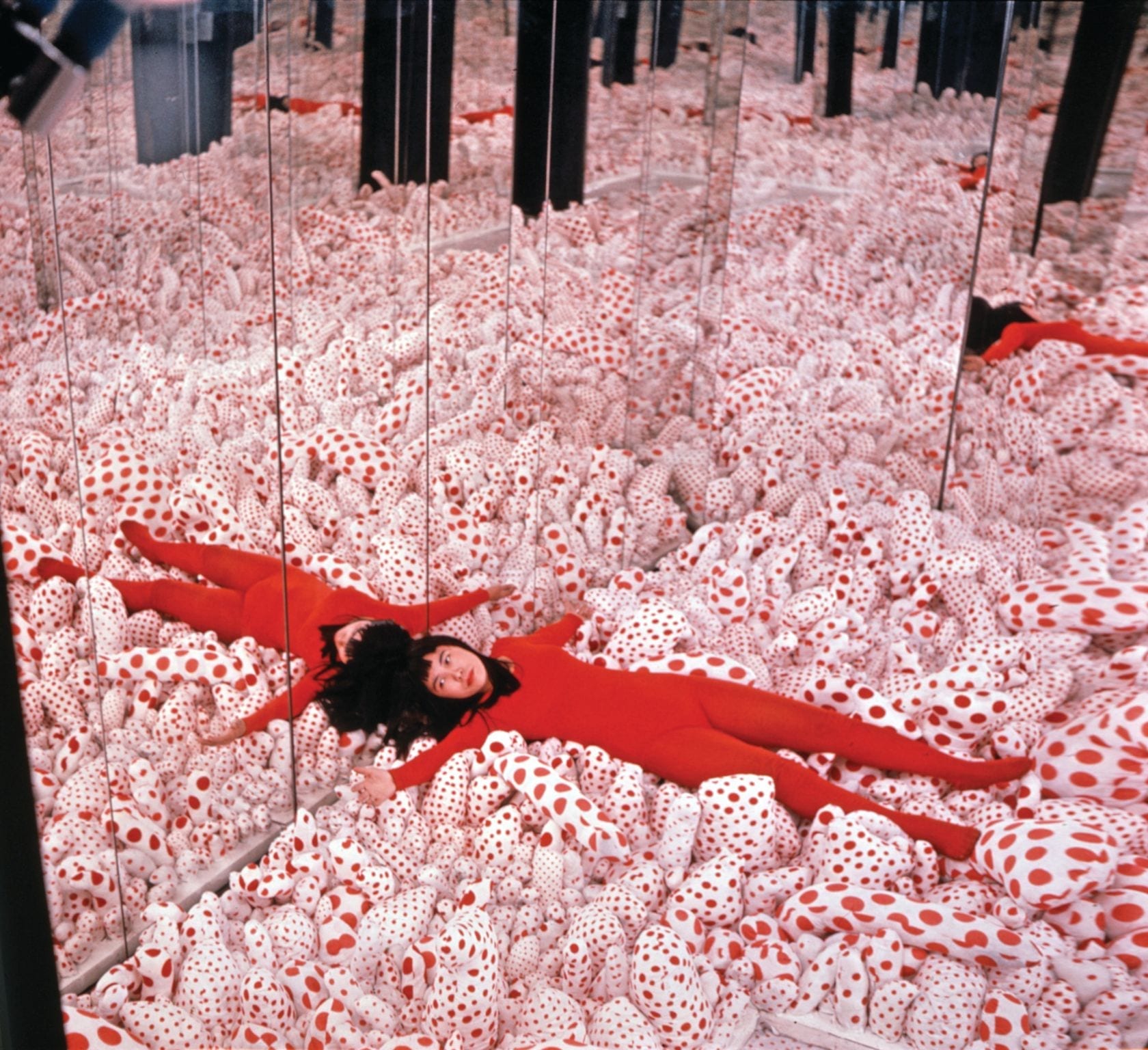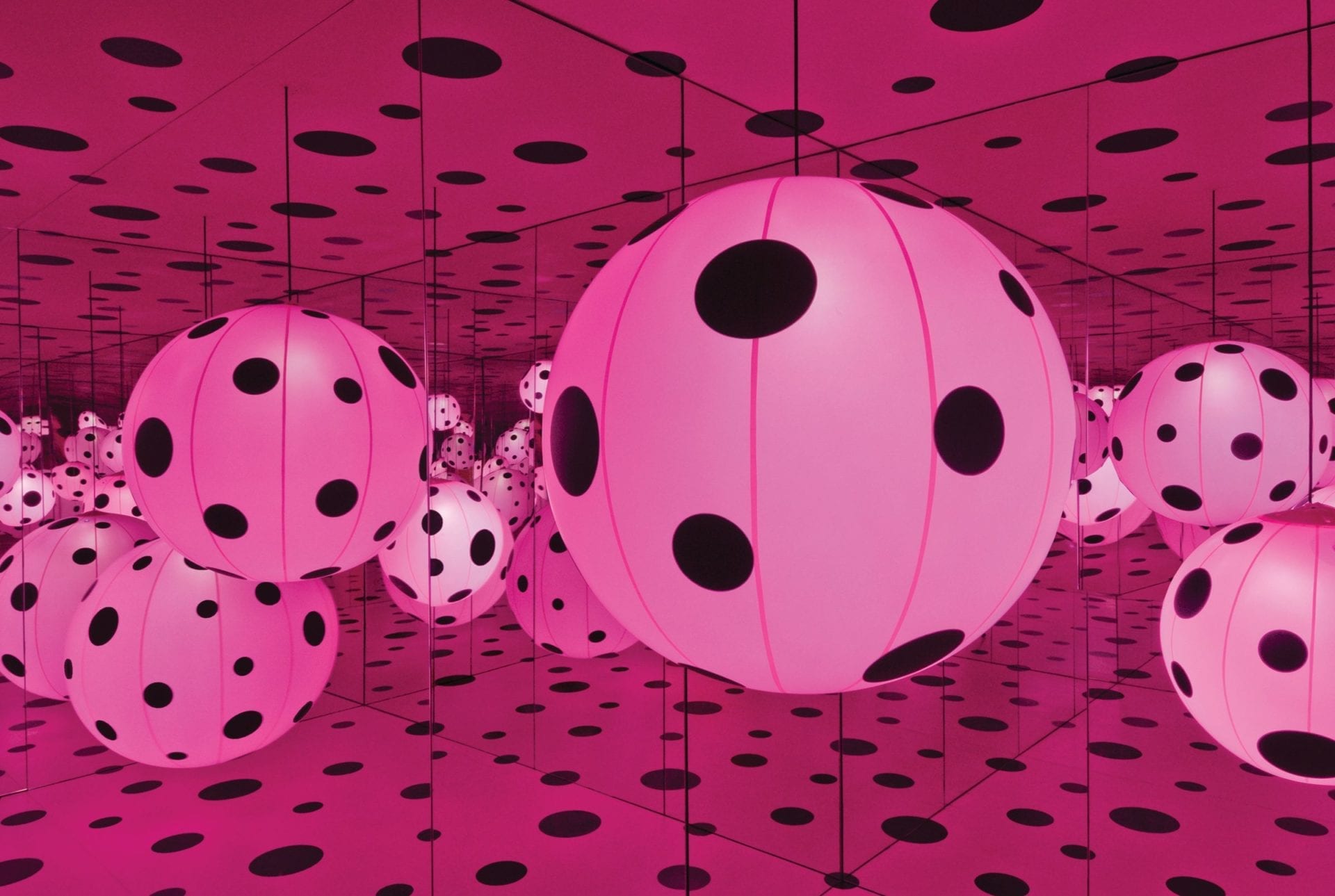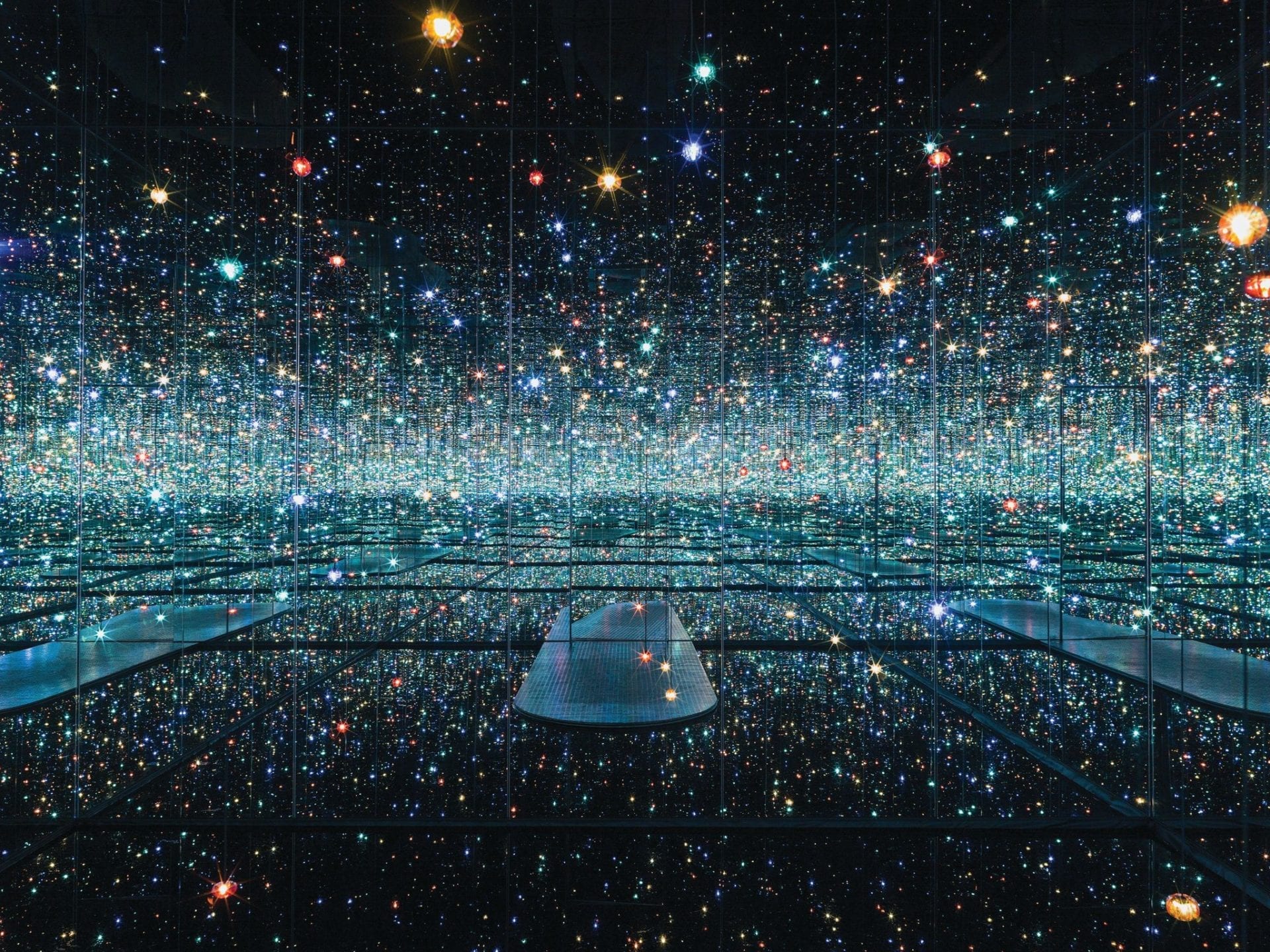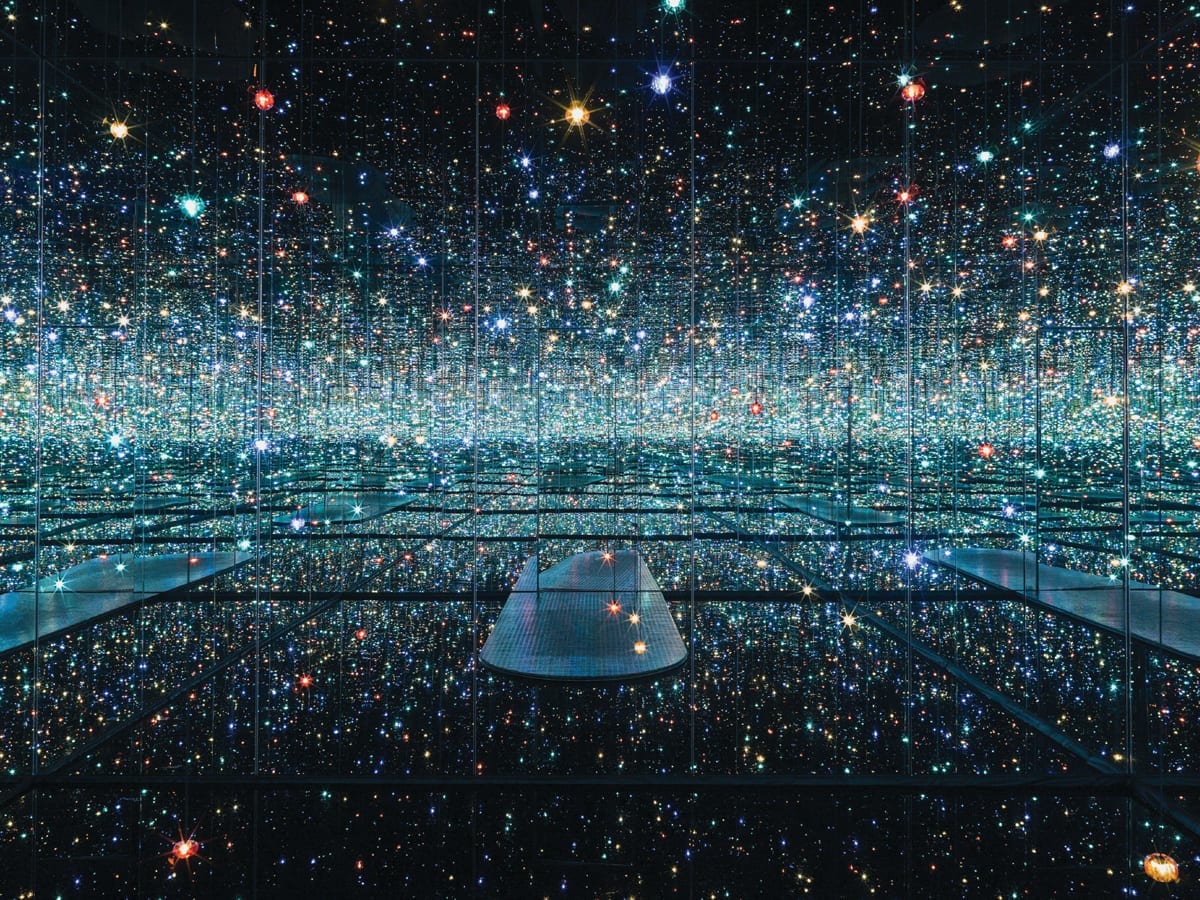“I, Kusama, am the modern Alice in Wonderland.”
Yayoi Kusama’s pointillist signature and gourd-shaped sculptures are instantly recognizable, and with more than 5 million people visiting her shows within the last five years, she is the most famous living female artist in the world. Known for her extensive use of polka dots and for her infinity room installations, the prolific contemporary Japanese artist has designed everything from Louis Vuitton handbags to lip gloss.
When Yayoi Kusama’s work is exhibited abroad, it is always situated in an international context. In order to get to the essence of Kusama’s work, art enthusiasts must visit her home country of Japan. The majority of her work lies in the capital city of Tokyo and her hometown of Matsumoto. Here’s where to go in order to get the ultimate Yayoi Kusama experience.
Born March 22, 1929, in the mountainous region of Matsumoto, Yayoi Kusama is the youngest daughter of a well-to-do conservative family of plant merchants.
Creating art was initially an act of rebellion—her mother did not want her to be an artist and frequently confiscated her artwork, hoping to force Kusama into the role of a traditional Japanese housewife. Painting was her way of bucking her parents’ old-fashioned customs and morals, and as a child, she often decorated her clothes with polka dots. In her youth, she created dozens of paintings a day, fearful that her work would be snatched from her before she could complete it. That fear seems to continue to dog her; Kusama works at a breakneck pace, and in her early years , she was capable of creating 250 pieces of art a year.

Kusama’s concepts, polka dots motif and lined meshed patterns she calls “infinity nets,” originate from visual and aural hallucinations that have haunted her since childhood, and art became a way of working through her psychological state and her obsessions. Her all-white, patterned and monochromatic Infinity Nets paintings allude to the artist’s hallucinations of being overwhelmed. Her work spans a number of mediums, including collage, drawing, fashion, film, installation, painting, performance, poetry and sculpture. Kusama has spent decades exploring the edges of subjects like life, death, class, ethnicity, gender, money, power and self-mythology. The green-and-black patterned painting Weeds and black-and-white dot painting Revived Soul use repetitive patterns of a single color paired against black or white. Following a lengthy correspondence with the American artist Georgia O’Keeffe, who became her friend and eventually her mentor, Kusama arrived in Seattle, Washington, from Japan in 1957 and moved to New York in 1958, intent on breaking into the male-dominated New York art world. In the early 1960s, through the simple use of water, mirrors and hanging lights, she began to create large-scale, immersive installations. In 1965, she produced her first Infinity Mirror Room at the Castellane Gallery in New York.
Her contemporaries, Claes Oldenburg, Andy Warhol and Lucas Samaras were inspired by her avant-garde conceptual explorations, so much so that a number of the artists imitated her style, embracing the imagery of natural life cycles. Her psychosexual works were a notable precursor to the post-minimalist art of the 1970s. Idiosyncratic, ahead of her time, and not well understood, after suffering through burnout and multiple suicide attempts, Kusama returned to Japan, eventually checking herself into the Seiwa Hospital for the Mentally Ill, which is still her residence. She visits her studio in the Shinjuku section of Tokyo daily.
Forgotten by the art establishment, Kusama kept creating. In a recent 18-month period, she created 100 paintings. For the last decade, Kusama’s paintings have strayed into realms of pure pop design featuring strong use of primary colors and cutout shapes, drawing comparisons to Matisse. The effect of her use of bright colors and bold patterns is simple in its presentation but deceptively complex in its execution.

Dots Obsession – Love Transformed Into Dots, 2007, at the Hirshhorn Museum and Sculpture Garden. COURTESY OF OTA FINE ARTS, TOKYO/SINGAPORE; VICTORIA MIRO, LONDON; DAVID ZWIRNER, NEW YORK., © YAYOI KUSAMA PHOTOGRAPH BY CATHY CARVER
With the rise of social media, the artist’s work has enjoyed a resurgence due to her work’s ability to sustain visual illusions on Instagram, and there are often hours-long lines to enter her museum and gallery shows. Her solo exhibitions have appeared at the Tate Modern in London, the Museo Nacional Centro de Arte Reina Sofía in Madrid, the Museum of Modern Art and Whitney Museum of American Art in New York, and the Centre Georges Pompidou in Paris. She was the first solo artist to represent Japan at the 1993 Venice Biennale.
Though, this was not Kusama’s first appearance at the Venice Biennale, with the earliest being considerably controversial. In 1966, at the age of 37, the artist displayed her infamous Narcissus Garden, which was partinstallation and part-performance, causing her to be expelled from the 33rd Biennale. Still on view elsewhere today, Narcissus Garden is comprised of 1,500 mirrored orbs laid on the ground encouraging visitors to play the role of the mythical Narcissus by peering into their own reflection. Wearing a golden kimono and poised among the orbs, Kusama sold them for two dollars each to passerby before being barred from the exhibition for her audacious, yet nonviolent, protest of the commercialization of art. Although Kusama was ahead of her time in this moment, her performance inspired a generation of artists who question the system and, today, the boldness of her work can be adequately recognized.
In 2006, she was awarded the Praemium Imperiale, one of Japan’s most prestigious arts prizes, and she is also the recipient of the International Art Critic Association prize, Golden prize from the Italian Academy of Arts, Asahi Prize and the Ordre des Arts et des Lettres. Kusama’s early Infinity Net pieces boast the highest auction prices of any living woman artist, and at 90 years old, she has created an estimated 50,000 works during a 60-year career. Still intrigued by the unfathomable mystery and infinitude of the universe, the queen of pop art shows few signs of slowing down.
Kusama’s hometown of Matsumoto honors her as one of the most important contemporary artists to come out of Japan. With a population that hovers around 250,000, the provincial city provides a reprieve from urban centers like Tokyo and Kyoto. Kusama’s birthplace is a fertile valley embedded in the center of Japan’s main island, Honshu. Located just two hours from Tokyo by train, Matsumoto, nestled close to the spectacular Japanese Alps, makes for a fantastic day trip for any art enthusiast. While her early work might’ve been controversial for this mountain town, the 21st-century sensibilities of the municipality’s residents have embraced Kusama—even the buses of Matsumoto sport Kusama’s signature polka dots.
While in town, the best way to experience the full range of Kusama’s body of work is to visit the Matsumoto City Museum of Art. Her sculpture, Flowers that Bloom at Midnight is displayed in the courtyard of the Museum. The eye-popping sculpture of plant life takes viewers on a psychedelic journey reminiscent of Alice in Wonderland. Even the building is wrapped in Kusama’s signature polka dots, and this museum, founded in 2002, has the greatest number of Kusama’s pieces outside of the artist’s namesake museum in Tokyo.
In a less than five minute drive from the Museum is the Matsumoto Castle, which is pleasantly tucked within the Matsumoto Castle Park and surrounded by a moat, walking paths and gardens with cherry blossoms. Also known as the “Crow Castle” due to its black exterior, Matsumoto Castle is one of the finest representations of Japanese architecture from the 16th century. For 280 years, it was one of the major seats of power in Japan and is listed as one of the country’s national treasures.

Infinity Mirrored Room – The Souls of Millions of Light Years Away, 2013. Made of mirrors, acrylic balls, water and an LED lighting system, Kusama creates a perceptual experience for viewers of the universe’s boundlessness. COURTESY OF DAVID ZWIRNER, N.Y. © YAYOI KUSAMA
If the luscious sights have left you with an appetite, authentic Japanese fare is offered nearby in a picturesque setting to extend your journey. True wasabi is hard to find outside of Japan—most of what Americans find on their plates at sushi restaurants is actually colored horseradish. So, if you’re up for a side excursion, Daio Wasabi Farm presents the opportunity to try the country’s delicacy in an idyllic farm-totable setting at the family’s onsite restaurant.
If wasabi isn’t your thing, but you’re in the mood to try the prefecture’s vegan and vegetarian dishes, make your way to Tofu Ryori Marui. Tofu might not sound like an interesting offering, but this outpost has been doing innovative things with this staple since the restaurant started over 80 years ago, which means their plates are sure to be anything but boring.
By Latria Graham

